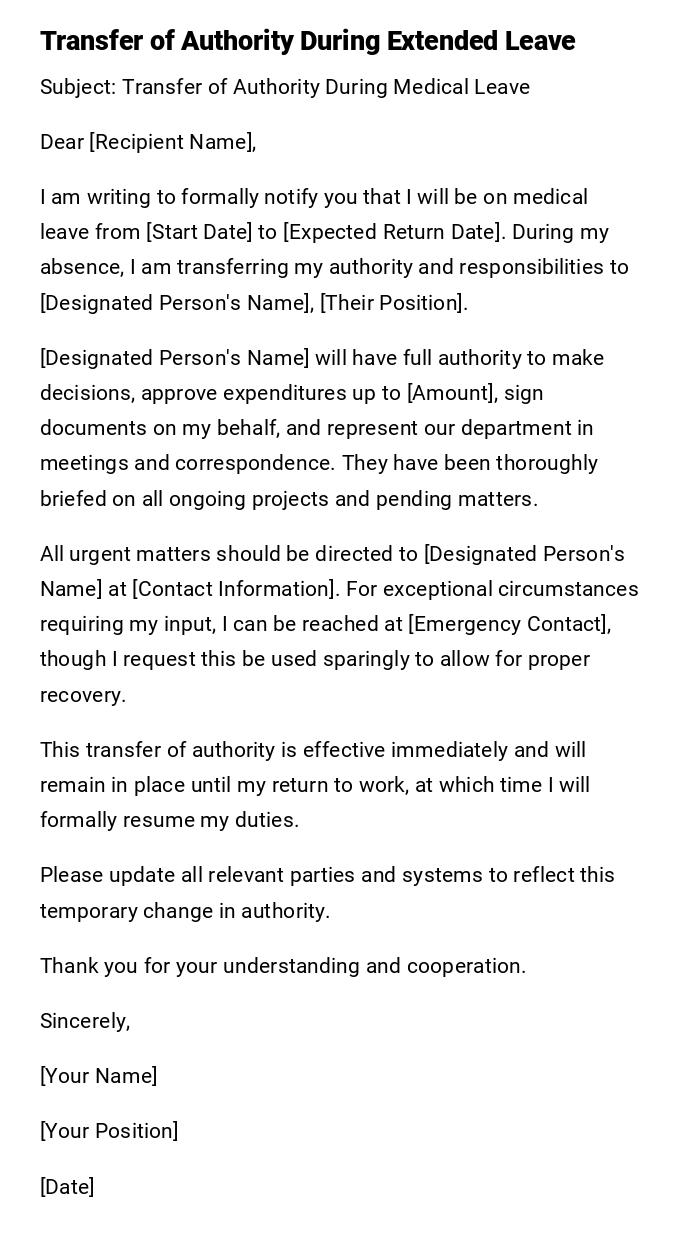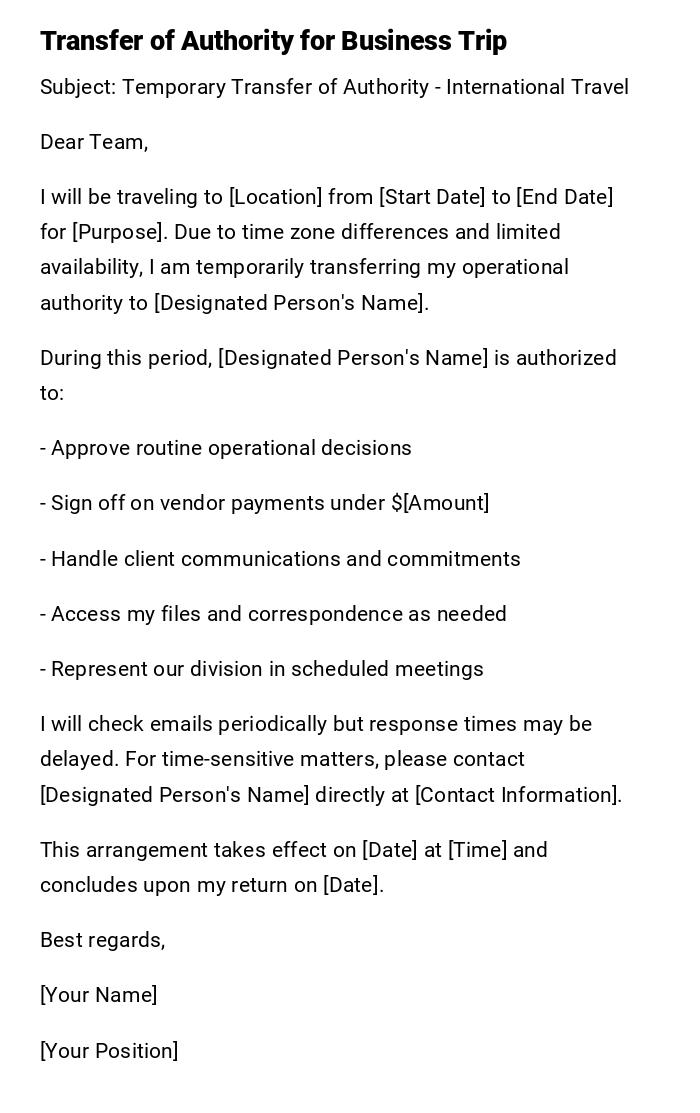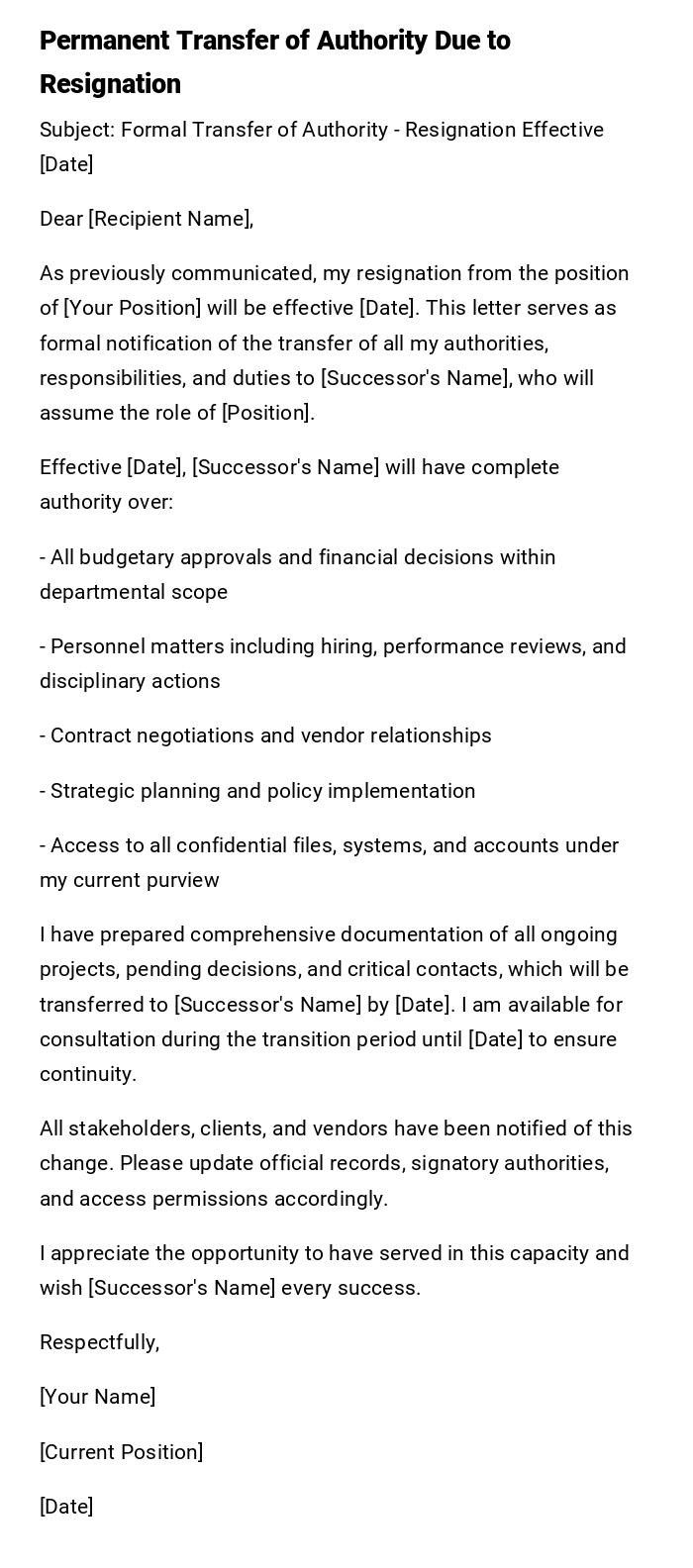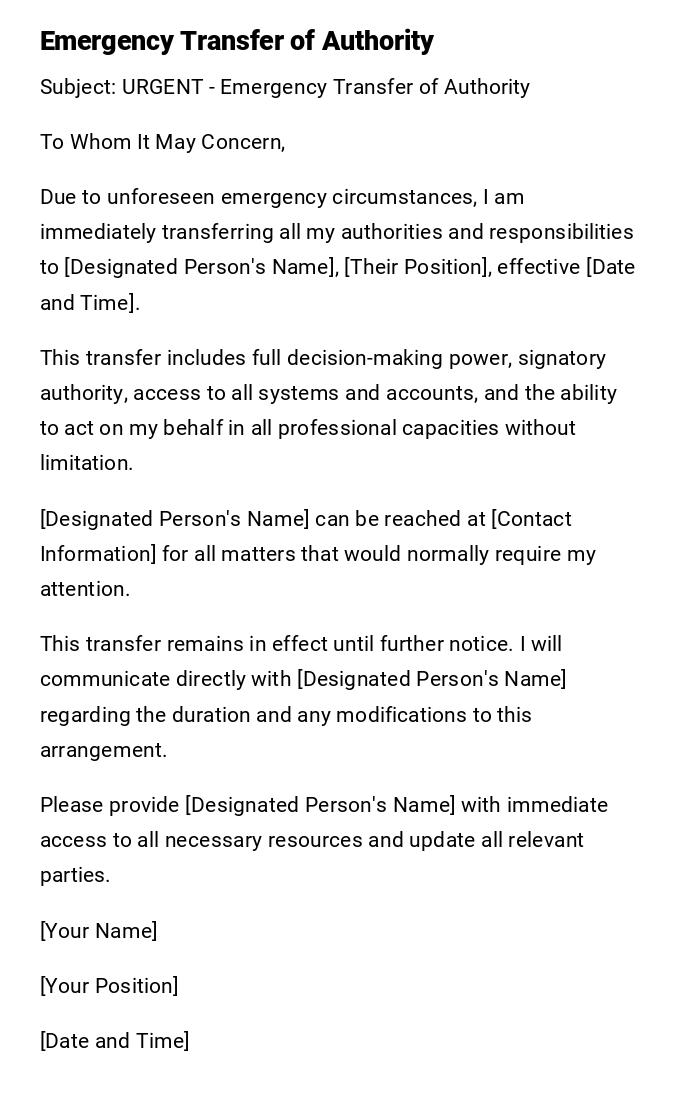Transfer Of Authority Letter
[Your Name]
[Your Address]
[City, State, Zip Code]
[Email Address]
[Phone Number]
[Date]
[Recipient's Name]
[Recipient's Title/Position]
[Company/Organization Name]
[Address]
[City, State, Zip Code]
Subject: Transfer of Authority Letter
Dear [Recipient's Name],
I hope this letter finds you well. I am writing to formally inform you of my decision to transfer the authority and responsibilities of my position at [Company/Organization Name]. As of [effective date], I will be stepping down from my current role as [Your Current Position] and passing on the authority to [Recipient's Name], who has been designated as my successor.
I have thoroughly considered this decision and believe that it is in the best interest of the company and its ongoing success. [Recipient's Name] has demonstrated exceptional skills and qualifications, and I have full confidence in their ability to carry out the duties and responsibilities of my position effectively.
As part of the transition process, I will work closely with [Recipient's Name] to ensure a smooth handover of responsibilities. I am committed to providing all necessary information, documents, and insights to facilitate a seamless transfer of authority. Additionally, I will make myself available for consultation and assistance during the transition period, should any questions or issues arise.
With this transfer of authority, I am confident that [Company/Organization Name] will continue to thrive and grow under [Recipient's Name]'s capable leadership. I trust that they will receive the support and cooperation from the team, just as I have throughout my tenure.
I would like to take this opportunity to express my sincere gratitude to the entire team for their collaboration and support during my time in this position. I have cherished the relationships I have built here and will carry the valuable experiences with me in my future endeavors.
If there are any specific tasks or projects that require immediate attention during the transition, please do not hesitate to inform me, and I will do my best to address them promptly.
Once again, thank you for the wonderful opportunities and experiences I have had during my tenure. I am confident that the company is in good hands and will continue to achieve new heights under [Recipient's Name]'s leadership.
Please feel free to contact me at [Your Email Address] or [Your Phone Number] if you need any further information or assistance during this transition.
Wishing you all the best for the future.
Sincerely,
[Your Name]
[Your Previous Position]
[Company/Organization Name]
Transfer of Authority During Extended Leave
Subject: Transfer of Authority During Medical Leave
Dear [Recipient Name],
I am writing to formally notify you that I will be on medical leave from [Start Date] to [Expected Return Date]. During my absence, I am transferring my authority and responsibilities to [Designated Person's Name], [Their Position].
[Designated Person's Name] will have full authority to make decisions, approve expenditures up to [Amount], sign documents on my behalf, and represent our department in meetings and correspondence. They have been thoroughly briefed on all ongoing projects and pending matters.
All urgent matters should be directed to [Designated Person's Name] at [Contact Information]. For exceptional circumstances requiring my input, I can be reached at [Emergency Contact], though I request this be used sparingly to allow for proper recovery.
This transfer of authority is effective immediately and will remain in place until my return to work, at which time I will formally resume my duties.
Please update all relevant parties and systems to reflect this temporary change in authority.
Thank you for your understanding and cooperation.
Sincerely,
[Your Name]
[Your Position]
[Date]
Transfer of Authority for Business Trip
Subject: Temporary Transfer of Authority - International Travel
Dear Team,
I will be traveling to [Location] from [Start Date] to [End Date] for [Purpose]. Due to time zone differences and limited availability, I am temporarily transferring my operational authority to [Designated Person's Name].
During this period, [Designated Person's Name] is authorized to:
- Approve routine operational decisions
- Sign off on vendor payments under $[Amount]
- Handle client communications and commitments
- Access my files and correspondence as needed
- Represent our division in scheduled meetings
I will check emails periodically but response times may be delayed. For time-sensitive matters, please contact [Designated Person's Name] directly at [Contact Information].
This arrangement takes effect on [Date] at [Time] and concludes upon my return on [Date].
Best regards,
[Your Name]
[Your Position]
Permanent Transfer of Authority Due to Resignation
Subject: Formal Transfer of Authority - Resignation Effective [Date]
Dear [Recipient Name],
As previously communicated, my resignation from the position of [Your Position] will be effective [Date]. This letter serves as formal notification of the transfer of all my authorities, responsibilities, and duties to [Successor's Name], who will assume the role of [Position].
Effective [Date], [Successor's Name] will have complete authority over:
- All budgetary approvals and financial decisions within departmental scope
- Personnel matters including hiring, performance reviews, and disciplinary actions
- Contract negotiations and vendor relationships
- Strategic planning and policy implementation
- Access to all confidential files, systems, and accounts under my current purview
I have prepared comprehensive documentation of all ongoing projects, pending decisions, and critical contacts, which will be transferred to [Successor's Name] by [Date]. I am available for consultation during the transition period until [Date] to ensure continuity.
All stakeholders, clients, and vendors have been notified of this change. Please update official records, signatory authorities, and access permissions accordingly.
I appreciate the opportunity to have served in this capacity and wish [Successor's Name] every success.
Respectfully,
[Your Name]
[Current Position]
[Date]
Emergency Transfer of Authority
Subject: URGENT - Emergency Transfer of Authority
To Whom It May Concern,
Due to unforeseen emergency circumstances, I am immediately transferring all my authorities and responsibilities to [Designated Person's Name], [Their Position], effective [Date and Time].
This transfer includes full decision-making power, signatory authority, access to all systems and accounts, and the ability to act on my behalf in all professional capacities without limitation.
[Designated Person's Name] can be reached at [Contact Information] for all matters that would normally require my attention.
This transfer remains in effect until further notice. I will communicate directly with [Designated Person's Name] regarding the duration and any modifications to this arrangement.
Please provide [Designated Person's Name] with immediate access to all necessary resources and update all relevant parties.
[Your Name]
[Your Position]
[Date and Time]
Transfer of Authority to Co-Manager
Subject: Shared Authority Arrangement - Vacation Period
Hi [Team/Recipient],
Quick heads up - I'll be on vacation from [Start Date] to [End Date] and completely disconnecting (finally!).
[Co-Manager's Name] will be running the show while I'm gone. They've got full authority to make calls on everything from approvals to putting out any fires that might pop up.
We've already synced on all the active projects and what's in the pipeline, so they're totally up to speed. Hit them up at [Contact Information] for anything you'd normally loop me in on.
I'll be back in the office on [Return Date] and will catch up on anything that happened while I was building sandcastles.
Thanks for keeping things rolling!
Cheers,
[Your Name]
Transfer of Authority Within Project Team
Subject: Transfer of Project Authority - [Project Name]
Dear [Recipient Name],
Effective [Date], I am transferring my authority as [Project Lead/Role] for [Project Name] to [Designated Person's Name]. This decision has been made due to [Reason: restructuring/new assignment/workload adjustment].
[Designated Person's Name] will assume full responsibility for:
- Project deliverables and timelines
- Budget management and resource allocation
- Client communications and stakeholder reporting
- Team supervision and task assignments
- Risk assessment and mitigation strategies
All project documentation, access credentials, and stakeholder contact information have been shared with [Designated Person's Name]. I have conducted a comprehensive handover session covering current status, challenges, and upcoming milestones.
The project team has been informed of this change, and I am confident in [Designated Person's Name]'s ability to lead this project to successful completion.
I will remain available for consultation through [Date] if needed, though [Designated Person's Name] has complete autonomy to make decisions.
Thank you,
[Your Name]
[Current Position]
Transfer of Signing Authority to Deputy
Subject: Delegation of Signing Authority
Dear [Recipient Name],
In accordance with organizational policy and for operational continuity, I am formally delegating my signing authority to [Deputy's Name], [Their Position], for the period of [Start Date] to [End Date].
This delegation grants [Deputy's Name] the authority to sign and approve:
- Financial documents up to [Amount]
- Contracts and agreements within standard parameters
- Official correspondence on behalf of [Department/Organization]
- Personnel-related documents excluding [Specific Exceptions]
- Regulatory submissions and compliance documents
This authority is granted under the provisions of [Policy/Regulation Reference] and is subject to all existing guidelines and approval thresholds. [Deputy's Name] has been thoroughly briefed on all protocols and limitations.
A copy of this letter should be maintained in official records and provided to all relevant departments including Finance, Legal, and Human Resources.
This delegation may be revoked at any time with written notice but will automatically expire on [End Date] unless extended in writing.
Formally,
[Your Name]
[Your Position]
[Organization]
[Date]
Transfer of Authority for Organizational Restructuring
Subject: Transfer of Authority - Organizational Restructuring
Dear [Recipient Name],
As part of the organizational restructuring announced on [Date], I am writing to formalize the transfer of specific authorities from my position to newly established roles within our department.
Effective [Date], the following transfers will take place:
[Authority Type 1] will be transferred to [Person Name], [New Position]
[Authority Type 2] will be transferred to [Person Name], [New Position]
[Authority Type 3] will be retained under my purview with modified scope
This restructuring aims to [Purpose: improve efficiency/better align responsibilities/support growth]. Each designated person has been selected based on their expertise and experience in the relevant areas.
Detailed documentation outlining the scope of each authority, approval limits, and reporting relationships will be distributed by [Date]. A transition meeting is scheduled for [Date and Time] to address questions and ensure smooth implementation.
All staff members, external partners, and stakeholders will be notified of these changes through official channels. Please update organizational charts, contact lists, and authorization systems accordingly.
I am committed to supporting all parties during this transition and am available to discuss any concerns.
Sincerely,
[Your Name]
[Your Position]
[Date]
What is a Transfer of Authority Letter and Why is it Needed?
A Transfer of Authority Letter is a formal document that officially delegates or reassigns decision-making power, responsibilities, and rights from one individual to another within an organization. This letter serves as legal documentation that authorizes a designated person to act on behalf of the original authority holder.
The primary purposes include:
- Legal Protection: Creates an official record that shields both parties from liability questions
- Operational Continuity: Ensures business operations continue smoothly during absences or transitions
- Clear Communication: Eliminates confusion about who has decision-making power
- Accountability: Establishes a clear chain of command and responsibility
- Compliance: Meets regulatory and organizational policy requirements for authority delegation
- Risk Management: Prevents operational paralysis when key decision-makers are unavailable
Who Should Send a Transfer of Authority Letter?
The letter should be sent by individuals who currently hold decision-making authority and need to transfer it temporarily or permanently:
- Senior Executives (CEOs, Presidents, Directors) transferring strategic authority
- Department Managers delegating operational responsibilities
- Project Leaders reassigning project control
- Financial Officers transferring budget approval rights
- Board Members delegating voting or decision rights
- Authorized Signatories transferring contractual signing power
- Property Owners delegating management authority
- Legal Guardians transferring custodial rights (in appropriate contexts)
- Government Officials delegating administrative powers
- Medical Professionals transferring patient care authority
The sender must have legitimate authority to transfer and the legal or organizational right to make such delegation.
When Should a Transfer of Authority Letter Be Issued?
Transfer of Authority Letters are triggered by various circumstances:
- Planned Absences: Vacations, business trips, conferences, sabbaticals
- Medical Leave: Illness, surgery, recovery periods, disability leave
- Parental Leave: Maternity, paternity, or adoption leave
- Emergency Situations: Unexpected hospitalization, family emergencies, natural disasters
- Career Transitions: Resignations, promotions, retirements, terminations
- Organizational Changes: Restructuring, mergers, department consolidation
- Temporary Reassignments: Special projects, task forces, temporary duty elsewhere
- Workload Management: Redistribution of excessive responsibilities
- Succession Planning: Gradual transfer to prepare successors
- Legal Requirements: Court orders, regulatory mandates, contractual obligations
- Performance Issues: Removal of authority due to underperformance or misconduct
- Conflict of Interest: Situations requiring temporary recusal from decision-making
Elements and Structure of a Transfer of Authority Letter
A comprehensive Transfer of Authority Letter should include:
- Clear Subject Line: Immediately identifies the letter's purpose
- Effective Dates: Specific start and end dates (or "until further notice")
- Parties Involved: Full names, titles, and positions of both transferor and transferee
- Scope of Authority: Detailed list of powers, responsibilities, and rights being transferred
- Limitations and Boundaries: Specific restrictions, approval thresholds, or excluded authorities
- Reason for Transfer: Brief explanation of circumstances necessitating the transfer
- Contact Information: How to reach both parties during the transfer period
- Authorization Statement: Explicit declaration of the transfer
- Access Provisions: Details about system access, files, accounts, or resources
- Reporting Requirements: How the transferee should communicate or report during the period
- Revocation Clause: Conditions under which the transfer can be cancelled
- Stakeholder Notification: Statement about who else has been or will be informed
- Signatures: Formal signatures of transferor and, when required, acknowledgment from transferee
- Date and Time: Precise timestamp of when the letter becomes effective
- Reference Numbers: Any applicable policy, regulation, or authorization codes
How to Write and Send a Transfer of Authority Letter
Follow this process to ensure proper transfer:
- Identify the Need: Determine why the transfer is necessary and its duration
- Choose the Right Person: Select someone with appropriate skills, experience, and availability
- Review Organizational Policies: Ensure compliance with company rules, bylaws, or regulations
- Define Scope Precisely: List exactly what authority is being transferred and what is excluded
- Conduct Briefings: Meet with the transferee to discuss ongoing matters, priorities, and protocols
- Draft the Letter: Use formal business letter format with all required elements
- Seek Legal Review: For significant transfers, have legal counsel review the document
- Obtain Necessary Approvals: Get sign-off from HR, upper management, or board as required
- Prepare Supporting Documents: Gather passwords, contact lists, project files, etc.
- Distribute Properly: Send to the transferee, immediate supervisor, HR, and all affected parties
- Update Systems: Ensure IT, finance, and administrative systems reflect the change
- Confirm Receipt: Verify that all parties have received and understood the transfer
Formatting Guidelines for Transfer of Authority Letters
Proper formatting ensures clarity and professionalism:
- Length: Typically one to two pages; concise but comprehensive
- Tone: Formal and professional for permanent transfers; can be slightly informal for temporary, routine delegations among colleagues
- Format: Standard business letter format with proper headers and signatures
- Language: Clear, unambiguous, and free of jargon; use active voice
- Structure: Organize with clear paragraphs, bullet points for lists of authorities
- Font: Professional fonts (Times New Roman, Arial, Calibri) in 11-12pt size
- Delivery Method:
- Email for routine, temporary transfers
- Hard copy with signature for permanent transfers or high-stakes situations
- Both digital and physical for critical transfers requiring documentation
- Copies: Always retain a copy for personal records and provide to all necessary parties
- Timeliness: Send with adequate notice (at least 3-5 business days when possible)
- Follow-up Format: Email confirmations acceptable; formal amendments require new letters
Requirements and Prerequisites Before Issuing the Letter
Before writing and sending a Transfer of Authority Letter, ensure:
- Legitimate Authority: Confirm you actually possess the authority you're transferring
- Organizational Permission: Obtain required approvals from supervisors or board
- Policy Compliance: Review company bylaws, policies, and procedures
- Legal Authorization: Verify legal right to delegate (some authorities cannot be transferred)
- Transferee Consent: Confirm the designated person accepts the responsibility
- Competency Verification: Ensure the transferee has necessary skills and knowledge
- Transition Planning: Prepare handover documents, briefing materials, and contact lists
- System Access: Arrange for appropriate permissions, passwords, and credentials
- Stakeholder Notification: Plan how and when to inform affected parties
- Documentation: Gather all relevant files, records, and information for transfer
- Timeline Clarity: Establish definite start and end dates or conditions
- Contingency Plans: Identify backup arrangements if the primary transferee becomes unavailable
- Insurance and Liability: Review insurance implications and liability coverage
What to Do After Sending the Transfer of Authority Letter
Post-sending responsibilities include:
- Confirmation: Verify all recipients received and understood the letter
- Access Provisioning: Ensure the transferee has all necessary system access and resources
- Stakeholder Communication: Inform clients, vendors, partners, and team members
- Monitoring: Check in periodically (if appropriate) to ensure smooth operation
- Availability: Remain accessible for consultation within agreed boundaries
- Documentation: Keep copies of all transfer-related correspondence
- System Updates: Verify that email auto-replies, signatures, and directories are updated
- Brief Period Observation: Monitor initial days to catch any issues early
- Formal Handback: When authority returns, issue a formal resumption notice
- Evaluation: After completion, assess how well the transfer worked for future improvement
- Thank You: Acknowledge the transferee's service upon resumption of duties
- No Follow-up Required: For routine, well-established transfers (like regular vacation coverage)
- Daily/Weekly Updates Required: For complex or high-risk authority transfers
Common Mistakes to Avoid
Watch out for these frequent errors:
- Vague Scope: Failing to clearly define what authority is and isn't being transferred
- Missing Dates: Not specifying exact effective dates or end conditions
- Inadequate Briefing: Transferring authority without proper knowledge transfer
- Lack of Limits: Not setting clear boundaries or approval thresholds
- Poor Timing: Sending the letter too close to the effective date
- Insufficient Distribution: Failing to notify all affected parties
- No System Updates: Forgetting to change access permissions and authorizations
- Verbal-Only Arrangements: Relying on informal agreements without documentation
- Assuming Acceptance: Not confirming the transferee agrees to take on the responsibility
- Ignoring Policies: Bypassing required approvals or violating organizational procedures
- Incomplete Contact Info: Not providing emergency contact methods
- Overlapping Authority: Creating confusion by partially transferring without clarity
- No Contingency: Failing to name a backup if the primary transferee is unavailable
- Permanent Tone for Temporary: Using language that suggests permanence for temporary transfers
Advantages and Disadvantages of Transfer of Authority Letters
Advantages:
- Ensures business continuity during absences
- Provides legal protection for decisions made by transferee
- Creates clear accountability and responsibility
- Prevents operational paralysis
- Documents delegation for audit and compliance purposes
- Facilitates professional development of deputies
- Reduces bottlenecks in decision-making
Disadvantages:
- Can create confusion if not communicated properly
- May undermine authority if perceived as lack of confidence
- Risk of decisions inconsistent with your approach
- Potential for scope creep beyond intended authority
- Administrative burden of proper documentation
- Possible resistance from teams unused to new authority figure
- Can complicate accountability if things go wrong
Comparing Transfer of Authority with Similar Documents
Transfer of Authority vs. Power of Attorney:
- Transfer of Authority: Limited to organizational/professional context
- Power of Attorney: Broader legal document covering personal and financial matters
Transfer of Authority vs. Delegation Letter:
- Transfer: Complete handoff of authority for specific period
- Delegation: May retain some oversight while assigning tasks
Transfer of Authority vs. Acting Appointment:
- Transfer: Temporary use of someone else's authority
- Acting Appointment: Temporary promotion to a vacant position
Transfer of Authority vs. Succession Planning:
- Transfer: Immediate, tactical authority shift
- Succession: Long-term strategic leadership transition
Alternatives to Consider:
- Shared authority arrangements
- Committee-based decision making
- Pre-approved decision frameworks
- Escalation protocols instead of full transfer
Tips and Best Practices for Transfer of Authority Letters
- Be Specific: Use exact dates, times, and detailed scope descriptions
- Set Clear Limits: Define approval thresholds in monetary terms or other measurable criteria
- Create Checklists: Develop standardized templates for recurring transfers
- Use Bullet Points: List authorities and responsibilities for easy reference
- Include Examples: Provide specific scenarios showing how authority should be exercised
- Build in Reviews: For extended transfers, schedule periodic check-ins
- Document Everything: Keep detailed records of what was transferred and when
- Communicate Broadly: Over-communicate rather than under-communicate the change
- Test Access Early: Verify system permissions work before you're unavailable
- Prepare FAQs: Anticipate questions and provide answers to the transferee
- Name a Secondary: Identify a backup person in case primary transferee is unavailable
- Use Templates: Develop organizational templates for common transfer scenarios
- Digital and Physical: Maintain both formats for important transfers
- Calendar Reminders: Set reminders for when authority should be reclaimed
Frequently Asked Questions About Transfer of Authority Letters
Can I transfer authority verbally? While verbal arrangements might work informally, written documentation is essential for legal protection and clarity.
How much notice should I give? Minimum 3-5 business days for routine transfers; 2-4 weeks for complex authority transfers.
Can I transfer partial authority? Yes, you can transfer specific aspects while retaining others, but clarity is essential.
What if the transferee makes a bad decision? Typically, the organization bears responsibility for decisions made within the scope of properly transferred authority.
Can I revoke a transfer early? Yes, but you must issue formal written notice to all parties who received the original letter.
Do I need legal approval? For significant transfers (executive authority, large financial power), legal review is recommended.
Can someone refuse a transfer of authority? Yes, unless it's part of their job description, acceptance is typically voluntary.
How long can authority be transferred? This varies by organization; check policies for maximum periods (often 3-6 months for single transfer).
What if I'm unreachable during the transfer? Establish emergency contact protocols or ensure the transfer is comprehensive enough that your input isn't needed.
Should the transferee sign the letter? Best practice is to have them sign an acknowledgment, though not always required.
Does a Transfer of Authority Letter Require Attestation or Authorization?
For routine, temporary transfers (vacation coverage, short-term leave), attestation is typically not required beyond standard organizational approval.
However, these situations DO require formal attestation or authorization:
- Significant Financial Authority: Transfers involving large budget control or signing authority
- Legal Authority: Power to enter contracts, bind the organization legally
- Executive-Level Authority: CEO, President, or Board-level powers
- Fiduciary Responsibilities: Authority over trusts, investments, or stakeholder funds
- Regulatory Compliance: Industries with strict oversight (finance, healthcare, government)
- Permanent Transfers: Any non-temporary reassignment of authority
Required attestations may include:
- Board resolution or approval
- HR department verification
- Legal counsel review and sign-off
- Notarization for certain high-stakes transfers
- Witness signatures
- Corporate seal
- Regulatory filing or notification










 Download Word Doc
Download Word Doc
 Download PDF
Download PDF